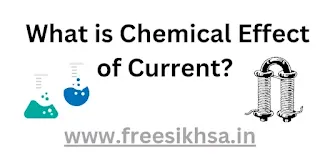What is Chemical Effect of Current ?
The chemical effect of an electric current refers to the chemical reactions that occur when an electric current is passed through a chemical solution or a molten electrolyte. This effect is also known as electrolysis.
During electrolysis, the electric current causes the ions in the solution to move towards the electrodes, where they undergo chemical reactions. At the cathode (negative electrode), positively charged ions (cations) gain electrons and are reduced, while at the anode (positive electrode), negatively charged ions (anions) lose electrons and are oxidized.
The products of the electrolysis reaction depend on the nature of the electrolyte and the type of electrode used. For example, if a solution of sodium chloride (NaCl) is electrolyzed using inert electrodes such as platinum, the products will be hydrogen gas (H2) at the cathode and chlorine gas (Cl2) at the anode. However, if the same solution is electrolyzed using a reactive metal electrode, such as a copper electrode, the products will be hydrogen gas at the cathode and metallic sodium (Na) at the anode.
Electrolysis has a wide range of industrial and laboratory applications, including the production of metals such as aluminum and copper, the purification of metals, the manufacture of chemicals such as chlorine, and the production of hydrogen gas.
What is Electrolyte ?
- Use Of Electrolyte : Electrolytes are commonly used in batteries, fuel cells, and electrochemical cells. They are also used in various industrial processes, including metal plating, electrorefining, and electroplating.
Uses Of Electrolyte ?
- Energy storage: Electrolytes are an essential component of batteries and fuel cells, where they help to transport ions between the electrodes and generate electrical energy.
- Industrial processes: Electrolytes are used in various industrial processes, such as electroplating, metal refining, and electrolysis.
- Medicine: Electrolytes are crucial for maintaining proper hydration, nerve and muscle function, and acid-base balance in the body. They are commonly used in sports drinks, IV fluids, and oral rehydration solutions to replace lost fluids and electrolytes in cases of dehydration or electrolyte imbalance.
- Water treatment: Electrolytes are used in water treatment to remove impurities and disinfect the water. Chlorine is a commonly used electrolyte for water disinfection.
- Analytical chemistry: Electrolytes are used in analytical chemistry to create conductive solutions that can be used for various analytical techniques such as conductivity measurement, ion-selective electrodes, and electrochemical sensors.
Principle of Electrolysis :
The principle of electrolysis is based on the fact that when an electric current is passed through a solution containing ions (an electrolyte), the ions are attracted to the oppositely charged electrode and undergo a chemical reaction. The electrode at which the positive ions (cations) are attracted is called the cathode, while the electrode at which the negative ions (anions) are attracted is called the anode.
- At the cathode, the cations gain electrons and are reduced, forming a new substance. The reduction reaction occurs because the electrons that are flowing through the electrode have a negative charge and are attracted to the positive cations. The type of reduction reaction that occurs at the cathode depends on the identity of the cation and the electrode material.
- At the anode, the anions lose electrons and are oxidized, forming a new substance. The oxidation reaction occurs because the electrons are being removed from the anion by the positive charge of the electrode. The type of oxidation reaction that occurs at the anode depends on the identity of the anion and the electrode material.
The overall reaction that occurs during electrolysis is determined by the type of electrolyte, the identity of the electrodes, and the strength of the electric current. Electrolysis is widely used in various industrial processes, including metal refining, electroplating, and the production of chemicals such as chlorine and hydrogen gas. It is also used in various laboratory experiments and analytical techniques.


